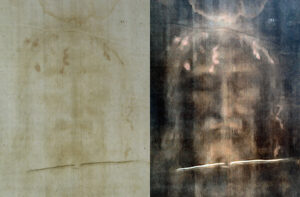By Dr. Don Bierle, FaithSearch President
I did a brief article on the Shroud of Turin about a year ago (Happ-O-getics, May 2022, Vol. 2, Issue 5). The Shroud is thought by many to be the burial cloth of Jesus (Matthew 27:59). What was already known at that time?
- Jesus was crucified at Passover in March-April.
- The extant burial cloth size (about 14’ x 4’) is typical of first century Jewish burials.
- The image on the cloth is of a scourged, crucified, and bearded Semitic male approximately 5’ 11” tall, whose blood serum shows evidence of great trauma.
- The blood stains correlate with the wounds in the biblical description of the crucifixion of Jesus.
- The image, a photographic negative, defies all known explanations of its formation.
- The Shroud is infused with Middle East pollen.
Additional evidence has now advanced the authenticity to make it nearly certain to be the burial cloth of Jesus. The Shroud is the most studied artifact in human history.
The Date
The radioactive measurement of the cloth in 1988 that indicated a thirteenth century origin, has now been conclusively shown to be based on a fiber of a reconstructed part of the Shroud (repaired after a fire). New evidence is two-fold. The flax fibers in the Shroud contain a compound called vanillin which decays at a fixed rate. If the Shroud was medieval in origin there should be at least a third of the vanillin left. There was none left, meaning the fiber is much older. Second, a new X-ray method of dating was used to make many measurements of the cloth. A first century date has been established. The cloth is from the time of Jesus.

Jewish Burial
The image on the cloth reveals it was a Jewish burial. The many discoveries supporting this are too numerous to mention in this article. Included among them is a strap across the forehead holding at its center a phylactery (box containing Scripture); a cloth size consistent with measures used by ancient Jews; remnants of aloes and myrrh (John 19:39); and the lack of a ritual water bath, an exception to Jewish custom if the victim was an outcast and if it was an official act of the Roman government.
Blood Stains
Dried blood is typically dark or black. The Shroud blood is still quite red. Physiology experts note that during torture the liver secretes bilirubin (red pigment) into the veins which produces blood with a lasting red color. Indeed, high amounts of bilirubin were found in the blood samples. High levels of creatinine and ferritin were also present, which is found in victims who have suffered a violent death.
Thorns
“And after weaving a crown of thorns, they put it on His head, and a reed in His right hand…” (Matthew 27:29). A thorn that grows in Jerusalem and blooms in March-April had the most pollen on the Shroud, mostly around the head area. An Israeli botanist identified at least nine thorns in the head area as well as a reed that lay along the victim’s arm.
Pollen grains
Thirty-six species of pollen have now been found on the Shroud, of which twenty are common in Jerusalem. Furthermore, nine species of blooming plants are represented which pollinate in March-April in Jerusalem, the time of Passover when Jesus was crucified.
Image

The image captured on the Shroud did not come from contact with the cloth. It is not art. No pigments, paints, dyes, or stains can be found. It is not a burnt image. It was formed by undefined electromagnetic energy from the body yielding a three-dimensional image. The brightness of the image varies according to the distance from the cloth. Since this distance can be measured with mathematical precision, a three-dimensional replica of the crucified man has been created with a VP-8 Image Analyzer. This cannot be done with any normal photograph.
Linen Cloth
The cloth is an expensive linen with a rare complex herringbone twill pattern, suggesting it was provided by a wealthy person (Matthew 27:57). Spectroscopy reveals it was created sometime between 300 B.C. and A.D. 400.
Limestone
Dirt particles on the nose, knees, and feet areas of the Shroud contain fragments of limestone (calcium carbonate) of the rare travertine aragonite variety unique to Israel.
Resurrection
There is no indication of decomposition of the body. It was still in rigor mortis which usually lasts from 24-48 hours. The body must have left the Shroud by that time. How did the body leave the Shroud? Pathologists state that the Shroud could not have been unwrapped. Since the cloth was loosely attached to the body by the dried blood, any attempt to remove it would damage the stains. Yet, such evidence is totally absent. Neither is there any evidence of damage to the image fibers. The conclusion is that the body left the Shroud without disturbing it.
Summary
Careful study of the biblical Gospels reveals that the crucifixion and the death of Jesus exactly parallels the crucifixion and death of the man of the Shroud. In 2022, French historian Jean-Christian Petitfils published the results of his four-decade-long study of the Shroud. In it he states: “My study is definitive in the sense that there is such a body of evidence that there is no going back on the discussion of authenticity… Its authenticity can no longer be disputed.” (Quoted in Newsmax.)
Faith Focus
Regardless of a person’s conclusion on this subject, for Christians, their faith should not be placed in the Shroud, but rather in Jesus who died for their sins and was raised by the power of God!
Sources: “The Real Face of Jesus,” Newsmax Magazine; April 11, 2023. The Shroud of Turin -The Perfect Summary. Kenneth E. Stevenson & Brian Donley Worrell, 2022. The Shroud and the Controversy. Kenneth E. Stevenson & Gary R. Habermas. Thomas Nelson, 1990.





AMEN TO THIS EVIDENCE OF OUR LORD JESUS CHRIST & EXHAUSTIVE STUDY.